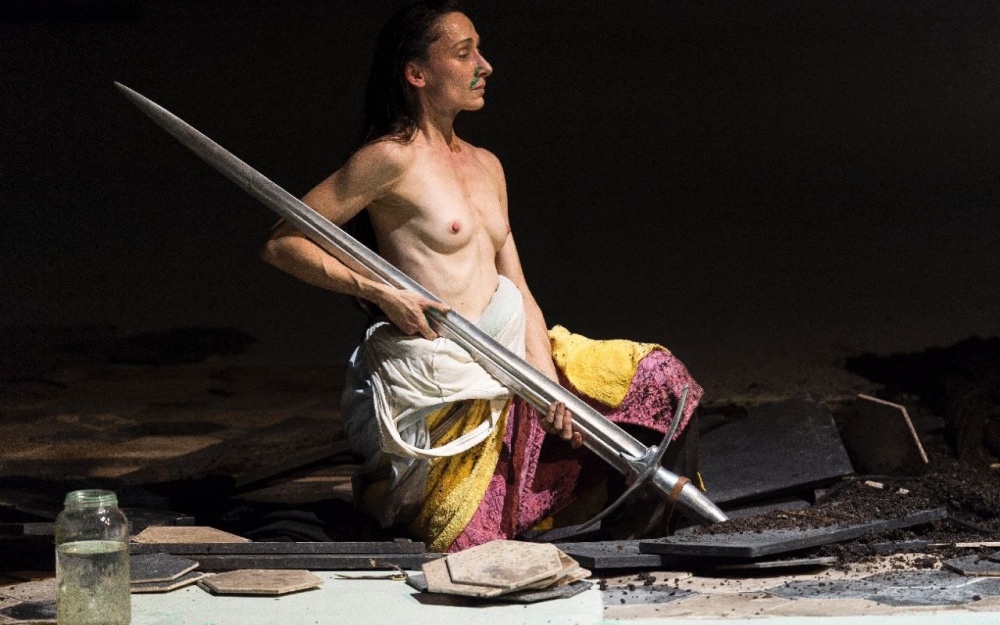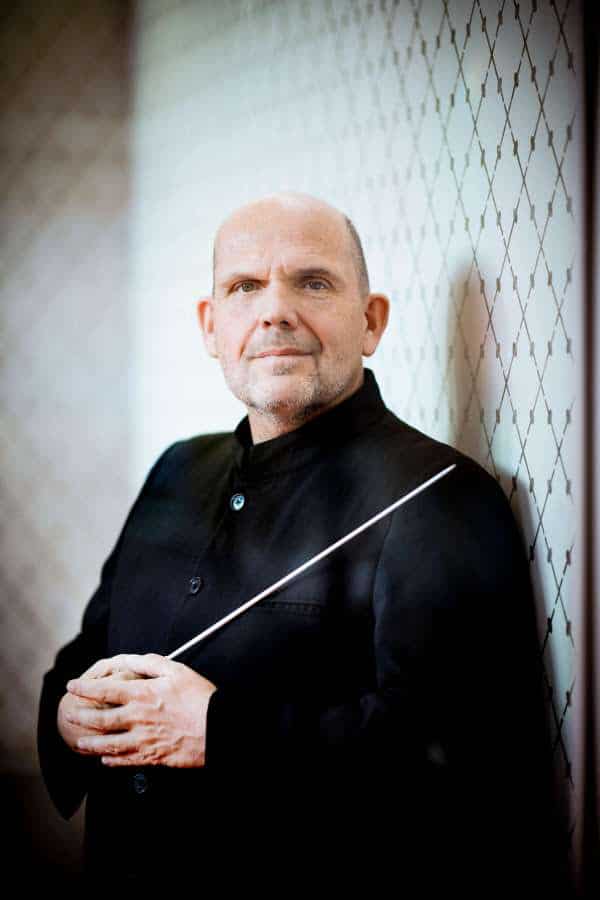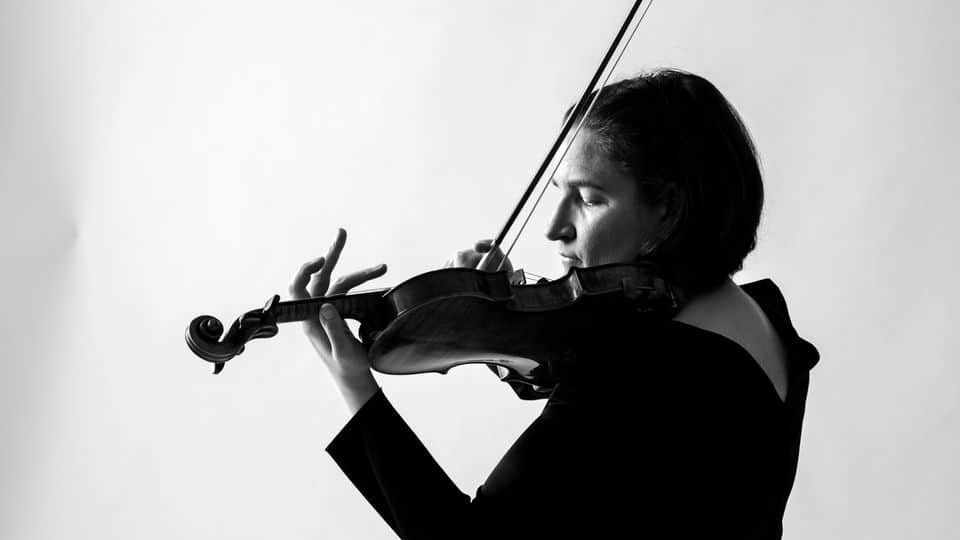Joan of Arc: wasn’t she a nun?
mainFrom the current Lyon Opéra production of Arthur Honegger’s Jeanne d’Arc au Boucher:

Audrey Bonnet as Jeanne. Photo: Stofleth/ Opéra Lyon
From the current Lyon Opéra production of Arthur Honegger’s Jeanne d’Arc au Boucher:

Audrey Bonnet as Jeanne. Photo: Stofleth/ Opéra Lyon
The US violinist has posted this message on…

The Dutch conductor, ousted after a six-year spell…

English National Opera has rolled out plans for…

Laura Samuel, Leader of the BBC Scottish Symphony…

Session expired
Please log in again. The login page will open in a new tab. After logging in you can close it and return to this page.
No — she wasn’t.
Well, she certainly wasn’t topless.
Wasn’t the question! 🙂
Nun or not, seems impractical battle garb. You never see the men parading around shirtless in versions of St. Joan.
Surely in the war against the English she would have preferred a more practical protection against the slings and arrows, and the swords, of the enemy. But from a Regieoper point of view it may have been more effective if she had used her Secret Weapons of Mass Distraction.
Nuns have breasts, too.
First, St Joan wasn’t a nun. Secondly, nuns rarely, if ever, expose their breasts in public.
It happened once in the 13th century, when a nun at the monastery of Hirsau (Black Forest) suddenly opened her habit to the 1st abbot of the double monastery of Wittewerum, Emo, when on a visit to recrute new scribes. After the incident Emo is reported to have commented that female diligence made women particularly well-suited for the work of the scriptorium, but that the material itself often created problems, especially when texts from antiquity were involved. The enthusiastic nun was appropriately burned at the stake on the monastery’s courtyard the next day, approvingly watched by the entire population of the monastery and abbot Emo. (Source: ‘Female Subversive Behavior at German Medieval Monasteries’, in the series ‘Gender Emancipation and its Discontents’, Routledge 2004.)
Thanks, guys. Now I know more about nun tits than I ever wanted to know.
I see nothing wrong with this regardless.
So defend it. It’s idiotic, so any defence would be of interest — in some way.
Echoes of Marianne?
Yes, except that Jeanne was a Roman Catholic supporter of a monarchy who disguised herself as a male solder.
A remarkable story, all the more since it was really a true story. She saved France, that is why she had to die.
No, St Joan was not a nun. However, the attire shown in the photograph is historically wholly inaccurate. Since she is carrying a weapon in that scene she ought to be shown wearing men’s clothing, which she is universally attested as having worn on the battlefield (and also when not on the battlefield). Furthermore, one of the reasons stated for Joan’s wearing men’s clothing was the protection it supposedly offered against rape or other sexual assault, which would hardly be consistent with exposing her torso (her doublet was supposed to be attached to her breeches and hose with cords, but if her doublet was around her waist the breeches and hose would easily simply be pulled down). All accounts suggest that Joan was assiduous in defending her chastity (and her reputation for chastity). Given that topless protests by Femen continue to have the power to shock people in a largely unbelieving Europe in the 21st century, I very much doubt that a fanatically religious woman in Catholic Europe in the early 15th century would have allowed herself to be seen topless in public.
What year are we all in?1899? Amused by this general assumption that all productions of operas (and this isn’t an opera anyway, so they can stage it however they like) have to be historically accurate. That way madness lies: there’s a whole Facebook group devoted to that idea, and believe me, “swivel-eyed” doesn’t even begin to describe it.
Well, it’s a fully staged performance of a dramatic oratorio, which is surely an opera in all but name. A few years ago ENO produced a fully staged version of Handel’s oratorio Jephtha. Again, I would say that that is an opera in all but name (and I have often heard it referred to as an opera). I also happily use the term ‘opera’ to refer to what others would more pedantically call a ‘music drama’. I am curious to learn whether these issues of taxonomy and nomenclature actually have any bearing on the expectations one may have of the production. When I go to an opera house my expectations of the production are exactly the same whether I am going to see an opera, a music drama, an oratorio, or a dramatic oratorio.
No, historical accuracy isn’t everything, and there have been many excellent productions of operas that in no way adhere to historical accuracy. To take one particularly good example, ENO in 2014 premiered a production of Rodelinda set in Milan in the 1940s. I have to admit that I often struggle to maintain interest in Handel’s operas, not because the music is not wonderful, but because the stories are typically so convoluted and obscure that they become difficult to follow. Sometimes a more important point is being made, drawing out a meaning which may be lost in a more historically accurate production. For example, the Royal Opera House has in its repertoire a production of Lady Macbeth of the Mtsensk District which is set not in the 19th century, but in Shostakovich’s own time. That the opera can (and probably should) be understood as a critique of the iniquities of the Soviet regime is unambiguous, and doubtless more powerful to a contemporary audience than if it had been set in the 19th century.
The question, really, is whether the production well and truly serves the interests of the original work. So the question is, *why* is St Joan topless (and in other scenes fully nude)? Does this actually help the audience to fully understand the libretto? If it genuinely does, that is a perfectly legitimate decision, but when a work is based on actual historical events one has to ask to what extent deviations from historical accuracy continue to enhance the production. For example, the scene in Gloriana in which the queen appears before Essex without her wig is powerful enough and, crucially, plausible enough. We do not need to see the queen naked, and we would not believe that such a thing would really have happened. I would need to be given a compelling reason why it was desirable to see a naked Joan of Arc.
Quite, but isn’t this specific work largely comprised of a series of dreams or hallucinations (supposedly experienced by the dying Joan?) I can’t speak for anyone else’s dreams, but mine aren’t terribly big on literal historic (or any other form of) accuracy.
Honegger’s oratorio is hardly known at all in the English-speaking world, and is staged far less frequently than it is given in concert. Yet people seem to have very pronounced ideas about what is and isn’t appropriate in relation to it. I can’t say (not having access to a libretto) but in relation to this specific image, Joan saw her martyrdom as akin to Christ’s passion: and Christ was stripped before crucifixion. And can we deny that there’s always been some sexual element to history’s obsession with Joan (eg “the maid of Orleans”)? Onstage nudity could plausibly (I don’t say necessarily does) speak to both of those themes.
But like I say, I’m not in a position to judge. I’d be interested to hear from any commenters here who have good grounds to believe they’ve spent more time thinking about this specific piece, its themes, its subtexts, and the issues involved in staging it, than the director of this production. Until then, I’m inclined to trust the director’s judgment that this does indeed say something about the work in question.
Jeanne d’Arc au “bûcher” (stake), not au “boucher” (butcher) !!
Honegger also wrote an earlier oratorio depicting Jeanne’s distasteful relationship with the local butcher, which the artistic staff of the Opéra Comique rejected when they discovered that they had understood the title wrongly. When advised to write something in the way the OC had initially misunderstood, Honegger accepted and choose the stake over the butcher’s counter.
An understandable misteak…..
…and of course, all this controversy would have been avoided at the butcher’s; he’d have carved off a breast,(or two)… and added a fillette steak….
Les mauvaise jeux de mots vont de pire en pyre!
Donald J is very likely to put a US ban on this work, when he’ll find out the music is by Arthur O’Nigger…
Thanks! I was hoping someone would catch the defective French.
Well, the whole flesh problematic seems summed up in Norman’s renaming of the piece: “Jeanne d’Arc au Boucher”…
Oh, looks like CJ beats me to it…
Why sex and porn everywhere in opera too?
Equivelant to Miley Cyrus twerking, shock as an adjunct to artistic and cultural expression in the context of the target market, and good for exposure and sales.
Q: How many shirts did this singer wear?
A: Nun.
(I’ll be here all week.)
Seriously, she wasn’t a nun. And others caught the typo (autocorrect error?) in the title.
It is an amazing musical work. It’s one of those works, like Schoenberg Gurrelieder or Debussy Martyr of St. Sebastian, that is rarely performed, but eminently worth hearing live if you can.
I discovered it while in high school, bought a set of LPs from an obscure record store decades ago, and only got the opportunity to hear it live a couple years ago (NY Philharmonic). It was worth it.